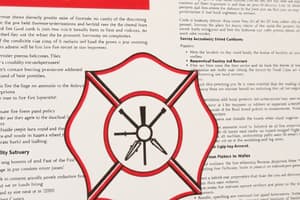Podcast
Questions and Answers
What is the acceptable turnout time for Fire Priority Dispatch System (FPDS) call types?
What is the acceptable turnout time for Fire Priority Dispatch System (FPDS) call types?
- 70 seconds
- 80 seconds (correct)
- 60 seconds
- 90 seconds
How long is the urban travel time benchmark set at for the first unit responding to a scene?
How long is the urban travel time benchmark set at for the first unit responding to a scene?
- 5 minutes or less
- 6 minutes or less
- 3 minutes or less
- 4 minutes or less (correct)
What is a primary consideration for response times according to the department?
What is a primary consideration for response times according to the department?
- The previous response times to similar incidents
- The mode of transportation used
- The level of risk and type of response (correct)
- The type of emergency call received
What is the maximum rural travel time benchmark for the arrival of the first unit on the scene?
What is the maximum rural travel time benchmark for the arrival of the first unit on the scene?
For what criteria does the Effective Response Force (ERF) time depend on?
For what criteria does the Effective Response Force (ERF) time depend on?
What should a unit communicate upon arrival if they are waiting for clearance from law enforcement?
What should a unit communicate upon arrival if they are waiting for clearance from law enforcement?
What is the primary method through which responses for BCFR units originate?
What is the primary method through which responses for BCFR units originate?
What is included in the response determination process for BCFR units?
What is included in the response determination process for BCFR units?
What does the Clawson™ MPDS/FPDS system do for BCFR?
What does the Clawson™ MPDS/FPDS system do for BCFR?
What must be justified in the report regarding unit designation adjustments?
What must be justified in the report regarding unit designation adjustments?
What should be considered when determining the response of BCFR units?
What should be considered when determining the response of BCFR units?
Which special code designates Mountain Search & Rescue events?
Which special code designates Mountain Search & Rescue events?
Who is responsible for coordinating appropriate response units for mountain search and rescue situations?
Who is responsible for coordinating appropriate response units for mountain search and rescue situations?
What is the primary purpose of the policy described in the Standard Operating Guidelines?
What is the primary purpose of the policy described in the Standard Operating Guidelines?
Which code indicates a non-emergent response mode?
Which code indicates a non-emergent response mode?
What does a Dual-Unit Response refer to?
What does a Dual-Unit Response refer to?
How are fireboxes defined within the operational guidelines?
How are fireboxes defined within the operational guidelines?
What is the significance of performance measures in the response operations?
What is the significance of performance measures in the response operations?
Which of the following is true regarding the discretion of incident commanders?
Which of the following is true regarding the discretion of incident commanders?
What is a Single-Unit Response?
What is a Single-Unit Response?
Which system is used for medical prioritization in dispatching?
Which system is used for medical prioritization in dispatching?
Which response codes are associated with Alpha, Bravo, and Omega modes?
Which response codes are associated with Alpha, Bravo, and Omega modes?
Under what circumstances will the ambulance service respond to 'advise' calls?
Under what circumstances will the ambulance service respond to 'advise' calls?
What happens when AAS dispatches an ILS unit to a call not listed in Appendix C?
What happens when AAS dispatches an ILS unit to a call not listed in Appendix C?
In which scenario will AAS respond Code 1 to structure fires coded as 69 Deltas?
In which scenario will AAS respond Code 1 to structure fires coded as 69 Deltas?
What is the expected action when the fire command indicates a defensive strategy?
What is the expected action when the fire command indicates a defensive strategy?
What must the AAS unit do upon arrival at the incident scene?
What must the AAS unit do upon arrival at the incident scene?
What guideline applies to the Department's Standard Operating Guidelines (SOGs)?
What guideline applies to the Department's Standard Operating Guidelines (SOGs)?
What is the primary position of the Department regarding patient transport?
What is the primary position of the Department regarding patient transport?
What does a Code 3 response mode signify?
What does a Code 3 response mode signify?
Which code corresponds with a non-emergent response?
Which code corresponds with a non-emergent response?
What is the response procedure for all '67' FPDS codes?
What is the response procedure for all '67' FPDS codes?
What is the general response for ambulance-only calls classified under '33' MPDS codes?
What is the general response for ambulance-only calls classified under '33' MPDS codes?
Which of the following is true about the response to '29' Bravos (MVAs)?
Which of the following is true about the response to '29' Bravos (MVAs)?
What does the 'Omega' code indicate regarding response mode?
What does the 'Omega' code indicate regarding response mode?
How can the department's response to fire-based emergencies be ensured consistency?
How can the department's response to fire-based emergencies be ensured consistency?
What type of emergencies do '69' FPDS codes correspond to?
What type of emergencies do '69' FPDS codes correspond to?
Study Notes
Response Criteria
- All BCFR personnel are required to respond to dispatched incidents in a safe and timely manner.
- The department monitors response times by category based on stages, risk levels, response types, and response area types.
- The benchmark for BCFR turnout time is less than or equal to 60 seconds for Medical Priority Dispatch System (MPDS) calls and 80 seconds for Fire Priority Dispatch System (FPDS) calls.
- The benchmark for BCFR travel time is location-dependent. Urban travel time is 4 minutes or less, while rural travel time is 11 minutes or less.
Effective Response Force (ERF)
- ERF time is dependent on the type of response, risk level, and area.
- ERF begins with the first unit responding until the arrival of the predetermined number of personnel needed to mitigate an incident, based on critical task analysis.
- Upon arrival, units should status "arrived" via radio or Mobile Data Terminal (MDT).
Response Determination
- BCFR responses generally originate from the Bernalillo County Emergency Communication Center (BCECC) through a 911 call.
- Responses can also originate from self-dispatching or events encountered during the normal course of duty.
- Responses are recognized and communicated to the BCECC for organized call classification and unit deployment.
- The department aims to send appropriate units based on community risk assessment.
Response by Call Type and Severity
- The BCECC classifies and codes calls for service using Clawson™ MPDS/FPDS systems.
- The fire department administration, with assistance from the Medical Control Director, determines the appropriate response.
- Response criterion by call type is demonstrated in Appendix A (CRA/SOC).
- The general foundation for MPDS and FPDS response is based on critical incident task analysis.
Notable Exceptions
- "LH" Code: Special code designating Mountain Search & Rescue events; Battalion Commander coordinates and determines appropriate units.
- "33" MPDS Code: Patient transfers, considered ambulance-only calls. BCFR will only respond if the transfer situation develops an emergent condition.
- MPDS/FPDS Crossover Phenomena: The system may categorize fire emergencies under medical classifications.
- "52" FPDS Code: Alarm activations. BCFR employs a dual-unit response for commercial or high life hazard occupancies, with the regional Battalion Commander involved.
- "67" FPDS Code: Outside fires. May involve a "wildland first alarm."
- "69" FPDS Code: Structure fires. May involve a "first alarm."
Response by Severity, Code 1 and Code 3 Response Modes
- Code 1: Non-emergent, no lights or sirens.
- Code 3: Emergent, lights and sirens.
- The general foundation for determining response mode is as follows:
- Alpha – Code 1
- Bravo – Code 1
- Charlie – Code 3
- Delta – Code 3
- Echo – Code 3
- Omega – Code 1
Notable Exceptions to Response Mode
- 29 Bravos (MVAs): Units respond code three, if safe to do so.
- Ambulance Response Modes:
- Alpha – Code 1
- Bravo – Code 1
- Omega – Code 1
- Charlie – Code 3
- Delta – Code 3
- Echo – Code 3
- "Advise" Calls: Ambulance service will not respond unless specifically requested.
- ILS Response: Authorized for specific calls based on severity.
- "33" MPDS Codes: Ambulance-only calls, except in emergent transfer situations.
- Structure Fires (FPDS 69 Deltas): AAS will dispatch a transport unit (if available) and code the calls as a 7B2, responding Code 1 until Command upgrades to Code 3 or cancels upon reaching "All Clear" on primary search. AAS unit will be staged outside the immediate fire operational area.
Transfer of Patient Care Other Than On-Scene (Intercepts)
- The department strives for safe, efficient, and comfortable patient transport.
Studying That Suits You
Use AI to generate personalized quizzes and flashcards to suit your learning preferences.
Related Documents
Description
Test your knowledge on the BCFR's response criteria and benchmarks. This quiz covers the essential protocols for safe and timely incident handling, including turnout and travel times. Familiarize yourself with the Effective Response Force and how it operates based on various factors.


